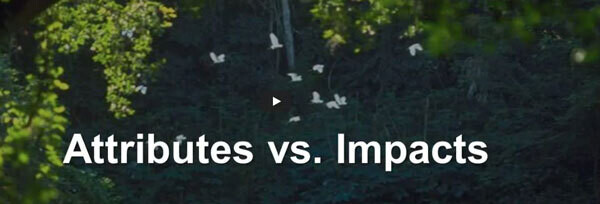Our New Video on Sustainability Attributes vs. Impacts: How LCA Insights Help You Reduce Risk, Serve Customers Better
With ever-increasing interest in sustainability, companies serving both consumer and B-to-B markets often find it beneficial to highlight an attribute of a product, process, or piece of packaging that sounds good from a sustainability perspective.

With ever-increasing interest in sustainability, companies serving both consumer and B-to-B markets often find it beneficial to highlight an attribute of a product, process, or piece of packaging that sounds good from a sustainability perspective.
You’ll see companies proudly saying that something is “biobased,” “made from recycled material,” or “recyclable,” as if these attributes alone make the item more sustainable or less impactful.
But unfortunately, that’s not always the case. And if your company is making these types of claims without a clear understanding of the impacts, it could be creating risk— which is why I felt motivated to create a brief video on the subject.
The potential for mismatch between good-sounding attributes and actual sustainable impact was brought home to me on the very first Life Cycle Assessment (LCA) I ever conducted. We were comparing two different remediation techniques. One removed 10 times more contaminant, which sounded great. But it required a piece of equipment that was 10 times as large. Because the lifetime of the system was relatively short, it turned out that the damaging pollution created during the manufacture of that larger mass of equipment was greater than what it could remove during the remediation process. Since then I’ve seen many instances where what seemed like the better product, based on its attributes, was in fact less sustainable when the full life cycle was assessed.
Another vivid illustration of how this applies in the sustainable packaging design world was recently provided by two wonderful researchers at the Oregon Department of Environmental Quality, Minal Mistry and Peter Canepa. Their study of how well packaging materials attributes correlated with the sustainability of the packaging itself found little to no correlation between the actual impact of packaging and attributes like “recycled content,” “biobased,” and “compostable.”
These types of disconnect put companies in a vulnerable position. If discovered and publicized by an outside researcher, the resulting bad press or social media uproar can undo years of reputation-building. And more broadly, customers who are seeking a more-sustainable option will move over time towards suppliers who actually deliver one. Worse, if a competitor feels they can show a claim is inaccurate, they may press a lawsuit or, in the US, ask the Federal Trade Commission for a ruling of unsubstantiated environmental claims (commonly known as “Greenwashing”).
We who use LCA and complementary sustainability assessment techniques to assess product and system sustainability have a responsibility to help our colleagues grasp the situation. It can sometimes be a struggle to make our findings understandable to decision-makers, and pushing back against the use of appealingly simple attributes as indicators of sustainability can be a lonely task.
That’s why I was motivated (following a workgroup discussion with Peter and others) to develop our brief new video that highlights several illustrative instances we’ve found where product sustainability attributes were not indicative of true sustainability impacts. I’m hoping it will be helpful in conveying this message within organizations and that you and your colleagues will find it useful.
Going forward, how can we make sure our attributes truly align with reduced impacts? More life cycle analysis is a good starting point. The growing body of LCAs (Google Scholar shows 4 million results for “life cycle assessment” with over 40,000 in the last eight months) allows us to look more deeply at how attributes align with sustainability impacts in specific situations.
While there is a certain amount of work and investment involved in the performance of sustainability assessments, it’s something that can pay dividends for years — and in many instances, getting a trade association or consortium involved can reduce the burden on any one organization.
Remember, it wasn’t easy the first time we rode a bike, swung a golf club, or tried to play the guitar. Assessing sustainability and finding ways to make it easy for people to understand and adopt will have an even longer learning curve, and it will require not just technical knowledge but also insight into organizations, systems, and human nature.
But it’s a curve worth being on. Our planet and its people — and all our grandkids — depend upon it.